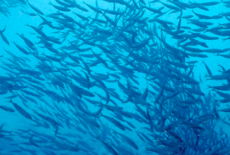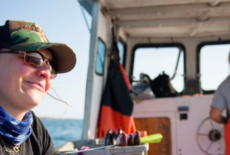These Super Rare Butterflies Thrive on Army Bases. The U.S. Military is Helping Them
Published April 17, 2019 on Nova Next
As planes take off at an Army National Guard airfield in Concord, New Hampshire, Elizabeth Crone and Nick Dorian carefully tiptoe through the greenery surrounding the runways. Heads down and decked out in the bright orange vests required of civilians who visit the airfield, Dorian and Crone focus on what no one else seems to notice: a tiny, delicate life form that’s arguably more reliant on the U.S. military than the soldiers are themselves.
Crone, a population ecologist at Tufts University, and Dorian, her graduate student, are searching for small green caterpillars barely distinguishable from the leaves they feed on. These critters are the next generation of the Karner Blue butterfly, an insect that landed on the Endangered Species List in 1992. While Karner Blue populations have been completely wiped out across much of the species’ former habitat, many of the healthiest populations of these butterflies still thrive on military bases—the more explosive, the better.
Crone has spent the last 20 years bouncing between military installations, including artillery ranges and weapons testing facilities, to study why some of the world’s most fragile and imperiled butterflies flourish in these simulated war zones. Cracking that question means working hand-in-hand with the Department of Defense (DoD), an agency that’s polarizing amongst environmental groups. While many major environmental voices have praised the agency for being a leader in climate change mitigation and clean energy solutions, the department has also been called “one of the world’s worst polluters” due to widespread instances of soil and water contamination in present and former military locations.
For scientists like Crone who are racing the clock to pull endangered populations back from the brink of extinction, military partnerships and DoD research funding are crucial. Some of the most robust populations of Karner Blues are found close to areas where bullets fly and bombs detonate. To preserve this and more than 400 other federally listed species that reside on DoD properties, Crone and environmental researchers across the country have formed unlikely, and sometimes complicated, alliances with military agencies.
“In general, people who study ecology are not big fans of the military,” Crone says. “Just accepting money from the military is not where you first think of looking as an ecologist.”
Bullets and Butterfly Wings
Crone avoided applying for funding from the Department of Defense for the first decade of her career as a university professor. But a mounting pile of scientific evidence on the unique biology of some endangered butterflies eventually persuaded her. Twenty-five years ago, Crone partnered with Cheryl Schultz—now a conservation biologist at Washington State University, Vancouver—to study the Fender’s Blue butterfly, a relative of the Karner Blue that was believed to be extinct until small populations were rediscovered in 1989.
Like Karner Blues, Fender’s Blue larvae dine solely on lupine plants—a genus that sprouts on open grasslands. Maintaining these habitats is challenging. If left alone, grasslands grow into shrub lands or forests that choke out low-growing lupines. And even though nature has its own system for preserving grasslands—roaming mammals feed on accumulating brush while periodic wildfires burn off overgrowth, eliminate weeds, and send lupine-loving nutrients into the soil—modern day humans have essentially wrecked that system by either taking over prairie lands entirely or corralling the animals and small fires that keep these areas intact. Controlled burns could help maintain grasslands, but they also introduce a conundrum: Use fire and some endangered larvae also go up in flames. But avoid fire and grasslands collapse—taking the butterflies, too.
In the early 90s, Oregon State University botanists Mark Wilson and Deborah Clark were studying post-fire lupine regrowth at the Baskett Slough National Wildlife Refuge. Schultz and Crone joined to observe how the Fender’s Blue might be affected, and in 1994, the team conducted high-intensity burns on three patches of dry land containing Fender’s Blue eggs and larvae. Flames ignited. Larvae died. And still, the butterflies multiplied. Following a repeat burn in 1996, the researchers found that Fender’s Blue females laid roughly four times more eggs in burned areas than they did in untouched control patches.
Fire helps jumpstart Fender’s Blue fertility because it clears out young forest growth that hinders lupine plants and it quickly converts organic material into ash, which releases nutrients and enriches soil much faster than natural decomposition. This newly-enriched soil not only stimulates growth of larger, healthier populations of lupine plants that can support bigger Fender’s Blue colonies—it also attracts ants that act like six-legged butterfly bodyguards. In exchange for feeding on sugars and amino acids secreted through glands on the Fender’s Blue caterpillar’s back, ants protect these caterpillars from predators, significantly increasing the caterpillars’ chance of survival.
Since those first fires, Schultz and Crone have done extensive work building models to determine how and when fire can be used to revive butterfly populations. They’ve found that hot, high-intensity burns—the kind that tend to ignite where guns and explosives go off—completely wipe out larvae, but over time, boost butterfly reproduction much more than lower-temperature burns done in cooler months or after rainfall.
“It’s kind of like a really hard fifth grade algebra word problem. If a fire kills half of the over-wintering larvae and if it increases the fecundity on the site by 10 percent, does that balance?” Crone says. “You can see why it’s controversial.”
For the Fender’s Blue, this controversial approach is working, which is why Crone has partnered with the DoD to collect preliminary data to determine whether the same methods will work for the Karner Blue. Since those early test fires at Baskett Slough, Fender’s Blue populations have increased at least nine-fold, possibly more. There are currently an estimated 14,000 to 28,000 Fender’s Blues flitting between lupine plants, Schultz says—a population size that’s large enough to give conservationists hope that the species will survive.
“Here’s a story where we’ve turned it around, but that’s not the usual story,” she says. “Many of our butterflies are sharply in decline, and not just the rare ones.”
Soldiers and Scientists
For environmental researchers, studying species that live on the 25 million acres of land managed by the DoD means dealing with military rules and restrictions. At Fort Bragg in North Carolina, Michigan State University ecologist Nick Haddad works alongside Brian Ball, one of nine wildlife biologists (plus one botanist) in the installation’s Endangered Species Branch, a division dedicated to managing and monitoring the five endangered species of flora and fauna found on base. Haddad and Ball have partnered up to save the St. Francis Satyr, a species of butterfly so rare it was thought to be extinct until a small population was discovered on base in the mid-90s. The tan and black species isn’t found anywhere else in the world besides Fort Bragg, and the healthiest colonies live on just 25 precious acres of land within the Fort’s borders.
The St. Francis Satyr relies on sedge plants, which grow in a specific type of murky wetland that quickly morphs into forestland if not maintained. In the wild, beavers build dams that remove trees and flood sedge plant habitat while brushfires burn off overgrowth. But North Carolina beavers are still recovering after being trapped to near-extinction in the early 1900s; humans, too, have eliminated natural, small-scale brushfires to protect infrastructure. So with beavers and brushfires in short supply, the largest and healthiest remaining populations of these butterflies now live inside Fort Bragg’s artillery impact zones, along creeks and drainage areas that catch fire from nearby munitions. Some smaller, less stable populations live outside of these fire-prone zones, but still within Bragg’s borders.
More than 50,000 active duty soldiers work on base, meaning that conservation efforts must work in tandem with training programs that restrict civilians from certain areas for safety reasons. Haddad and Ball are only allowed into artillery ranges once or twice a year, always with a military escort and for just a few hours. While the pair spends entire days working alongside Haddad’s graduate students and other researchers to meticulously track changes in Satyr population health outside of impact zones, they generally only get about 30 minutes per site inside impact zones and must leave their research partners behind. These limitations make it impossible to get exact population counts or to conduct intensive monitoring.
“I wish I had more access, but on other hand, I understand why I don’t and I’m comfortable with that because frankly, when I do go in [to impact zones], the butterflies are doing well there,” Haddad says. “My highest concern is outside those areas.”
Haddad and Ball are currently lobbying to artificially replicate spontaneous fires found within impact zones in Satyr habitat located outside of artillery areas. Fort Bragg already operates an extensive controlled burning program as part of larger conservation and ecosystem management efforts, but the St. Francis Satyr lives in wetlands and it’s “difficult to get fire into these areas consistently while being safe,” Ball says.
In the meantime, Haddad and Ball are replicating a different kind of natural disturbance: floods.
After years of watching local St. Francis Satyr populations go extinct, the pair adopted a new strategy in 2011: save the butterflies by acting like beavers. To prevent wetlands from transforming into dense forests, they began removing trees and flooding Satyr habitats, creating more hospitable conditions for sedge growth and for butterfly reproduction.
Satyr populations are also boosted by an on-site captive rearing program wherein butterflies are raised from eggs to adults in greenhouses, then released into wild colonies or onto restoration sites within Fort Bragg to reproduce.
Flooding combined with captive restoration have collectively transformed sites where Satyrs were once extinct into areas that boast populations of 800 or more. Haddad says that these new butterflies represent about 25 percent of the total St. Francis Satyr population.
“If it weren’t for the military and especially if it weren’t for these artillery ranges, the St. Francis Satyr would now be extinct,” he says.
Warriors and Woodpeckers
Haddad and Crone both enthusiastically praise their colleagues at the Department of Defense, but it’s only relatively recently that many within the research community and the general public began thinking of the department as an agency that prioritizes species preservation.
In the ’80s and ’90s, “there really was this perception that the DoD didn’t care about the bugs and bunny issues,” says Alison Dalsimer, manager of the department’s Natural Resources Program.
That perception slowly began to change thanks to the red-cockaded woodpecker, or RCW (as it would come to be known). The RCW thrives on longleaf pine, a tree that once occupied more than 90 million acres across the United States, but was logged down to less than 3.4 million by the early 21st century, taking woodpecker populations down with it. In 1988, a federal judge ruled that clear-cut logging violated the Endangered Species Act and banned the practice from happening within the woodpecker’s habitat. In the wake of the suit, the U.S. Fish and Wildlife Service issued a mandate requiring RCW protection at Fort Bragg and nearby Camp Mackall, thus launching the rocky start to a now crucial partnership between the military and conservationists and directly leading to the creation of new conservation management programs within military installations including Fort Bragg’s Endangered Species Branch.
Dalsimer calls the RCW ruling a “turning point” for engaging the DoD in conservation efforts and helping conservation partners see that, “‘Oh wow, the DoD actually does care.’”
Dalsimer counts herself among the converted. In the mid-’90s, just a few years following the RCW lawsuit, Dalsimer worked on behalf of the National Fish and Wildlife Foundation on a few joint projects with the DoD, including a review of research on natural resources located on military-owned lands that were scheduled to be transferred to the government of Panama. While working on these projects, she says she saw first-hand the department’s commitment to land stewardship. Dalsimer joined the department in 1997, where she currently oversees, among other initiatives, the DoD Partners in Flight program—one piece of a massive bird conservation collaboration that currently includes 150 partner organizations, the DoD being just one.
“The fact is the DoD is a premier steward of its resources and puts a lot of time and effort and money into managing those resources at a very high level,” she says. “I don’t know that people are really aware of that.”
For rare butterflies like the Karner Blue and the St. Francis Satyr, effective partnerships between ecologists and the military are the last remaining hope. Nick Haddad is cautiously optimistic. Buoyed by stories like that of the red-cockaded woodpecker—which has fully recovered on Fort Bragg—Haddad keeps a close vigil on his St. Francis Satyr colonies. He’s worried, but not discouraged. If he can replicate the success he’s had with Satyr colonies in places within military borders and beyond, “then there’s a realistic hope of calling this species recovered,” he says. “There is a path forward.”






